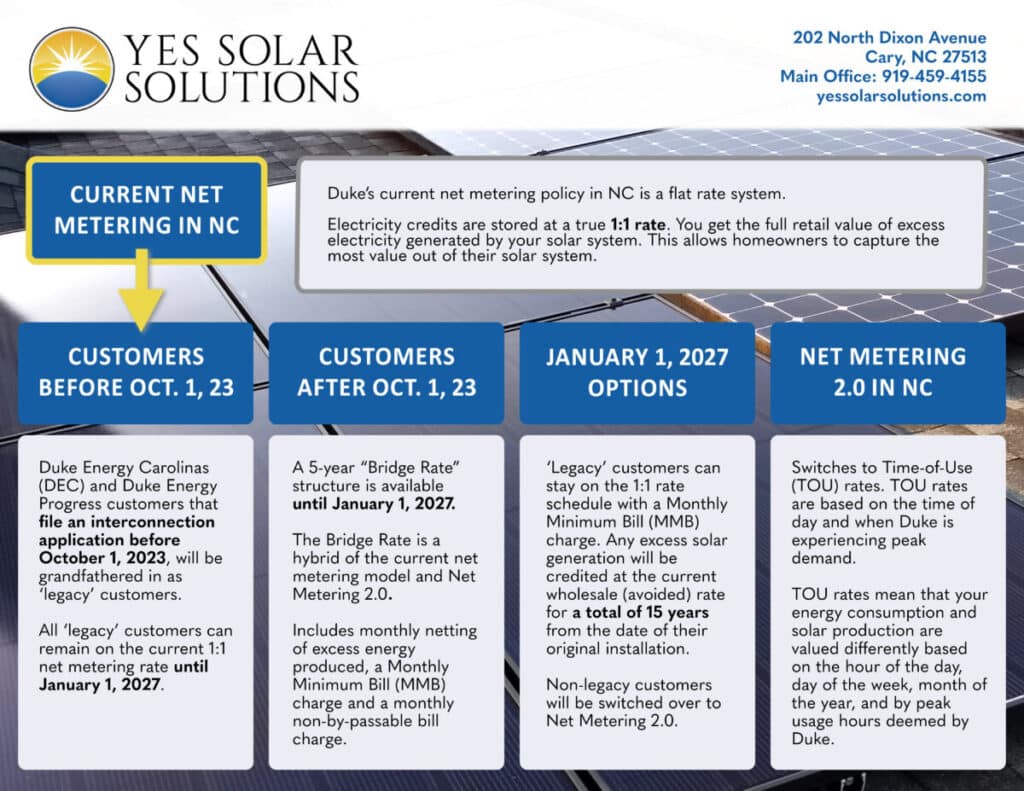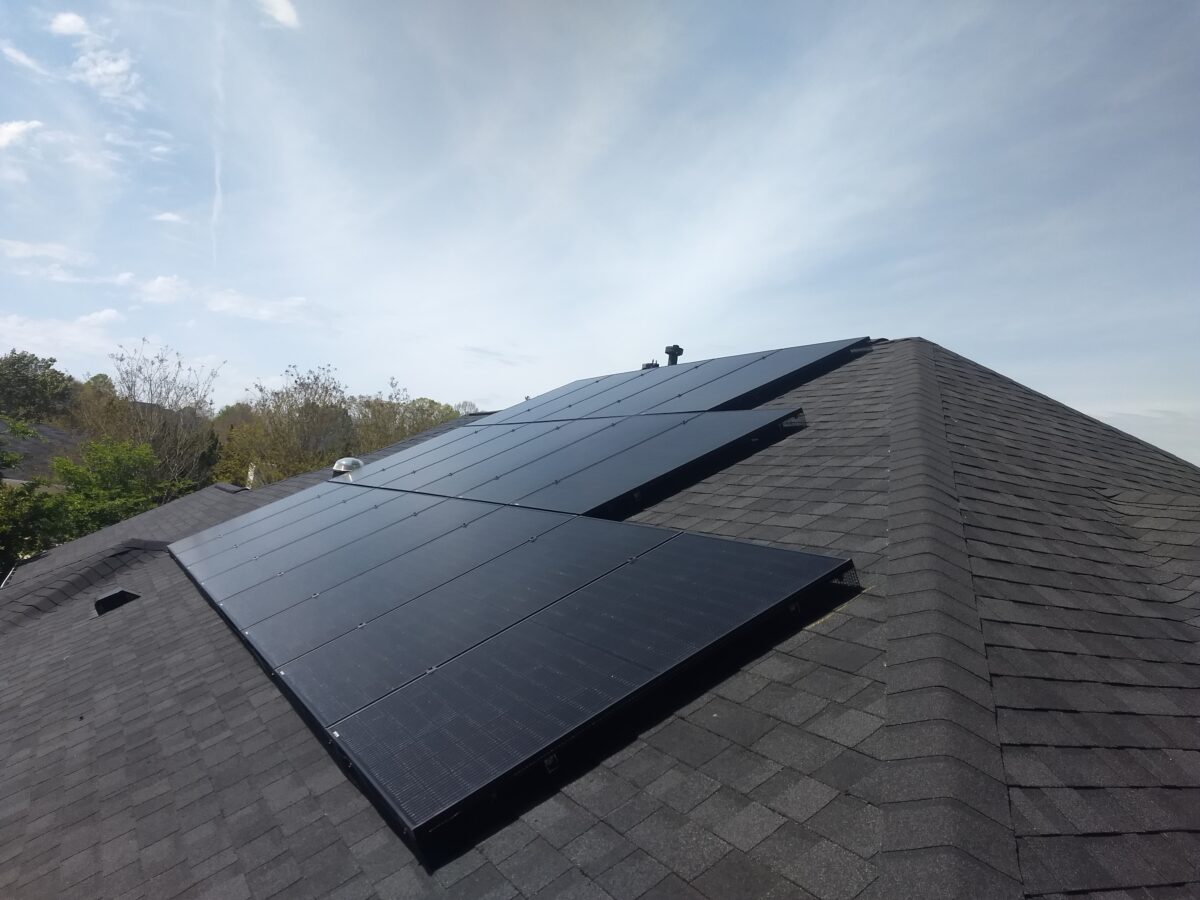What is Net Metering?
Net metering is the interconnection policy that controls how your solar system is connected to the grid and how you are credited for the solar energy you produce.
Duke Energy Carolinas (DEC) and Duke Energy Progress (DEP) customers that are able to file an interconnection application before October 1, 2023, will be grandfathered into the current solar net metering rate structure instead of having to move to Duke Energy’s Net Metering 2.0 policy, which will have complex and costly Time-of-Use (TOU) rates and Critical Peak Pricing (CPP) that will be required for customers.
What is the Current Net Metering Structure?
Duke’s current net metering policy in North Carolina is a flat rate system that provides electricity credits that are stored at a 1:1 rate. This means that you get the full retail value of excess electricity generated by your solar system.
The current net metering structure is the best interconnection policy for solar owners since it offers a true 1:1 credit. This allows homeowners to capture the most value out of their solar system.
What Happens to Legacy Customers After October 1st?
Legacy customers (and those who are grandfathered in) can remain on their current rate schedule and receive the full 1:1 credit for any excess solar generation until January 1, 2027.
At that time, Legacy Customers can opt to stay on their current rate schedule (with a Monthly Minimum Bill (MMB) charge equal to $10 more than the current Facilities Charge) and any excess solar generation will be credited at the current wholesale (avoided) rate for electricity.
Legacy customers may remain on this rate schedule for a total of 15 years from the date of their original installation.
What Happens if I Miss the October 1, 2023 Deadline?
Yes Solar Solutions (Cary, NC), Southern Energy Management (Raleigh NC), and Sundance Power (Weaverville, NC) also negotiated a 5-year “Bridge Rate” net metering structure that would last until January 1, 2027.
This Bridge Rate will allow solar customers to opt for a hybrid of the current net metering and Net Metering 2.0. The Bridge Rate includes monthly netting of excess energy produced based on the current avoided cost of electricity, a monthly minimum bill charge and a monthly non-by-passable bill charge.
This negotiated Bridge Rate would provide an option to prevent customers from having to fully move to TOU and CPP rates for 5 years.
Let’s Break This All Down

Net Metering 2.0
Net metering won’t be going away in 2.0, but rather changing forms. Net metering 2.0 includes switching to Time-of-Use (TOU) rates. TOU rates are based on the time of day and when Duke is experiencing peak demand. TOU rates mean that your energy consumption and solar production are valued differently based on the hour of the day, day of the week, month of the year, and by peak usage hours deemed by Duke.
The value of energy is outlined in a Time-of-Use (TOU) rate schedule, with Duke typically charging more for energy during peak demand hours. This is in contrast to the current flat rate system where usage and solar production are valued the same every hour of the day, year round.
Who Would Benefit from these Changes?
Well, Duke Energy. NC is the second state where Duke has developed a comprehensive net metering plan. The debate on net metering changes in other states (most famously California) has instigated discussion on who truly benefits from these changes. TOU rates would allow Duke to control demand and therefor control the value of energy, making Duke more money.
Who Would Be Adversely Affected by Net Metering 2.0?
A consortium of fifteen solar companies, led by long-time local installers Yes Solar Solutions (Cary, NC), Southern Energy Management (Raleigh NC), and Sundance Power (Weaverville, NC), and joined by 50 non-profits, believe these proposed net metering changes could harm the growing solar industry in NC, impact thousands of well-paying jobs, threaten the well-publicized energy goals for the State of NC, and limit the delivery of low-cost power to the grid, which affects all electricity customers.
Under the current net metering rate structure, the value of solar energy excess generation is equal to the retail rate you pay for electricity. It’s easy for solar companies to calculate a customer’s payback time period because we can look at a customer’s historic utility bill and Duke Energy’s current rates to estimate how much your solar energy production is worth.
Under the new program, the answer will not be quite so simple. Because of the way TOU and Critical Peak Pricing rates work, the value of solar will be extremely difficult to calculate accurately and provide estimates to a customer’s ROI and pay-off period.
Yes Solar Solutions Co-Founder and President Stew Miller is quoted in PV Magazine’s article on the letter, saying that Duke is “following the playbook that utilities in California and Florida are using to slow the growth of their only competitors … their current ratepayers that want the freedom to generate a portion of their own electricity.”
What Can a Consumer Do About Net Metering Changes?
If ever there was a time to invest in solar, it is now before any more net metering changes take effect. If you are on the fence or were thinking of putting off purchasing a solar system until next year, you should reconsider and move forward now, to be grandfathered in to the current net metering structure.
Contact us for a free quote!
